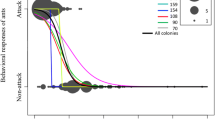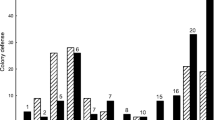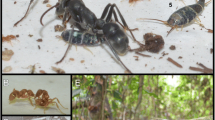Abstract
The cooperation and aggression between five laboratory colonies of Monomorium pharaonis were compared using an aggressiveness test and pupa-carrying test in laboratory arenas. The colonies were derived from field collections in different parts of Europe and USA. Generally, inter-colony aggressiveness was low and acceptance of pupae from other colonies was high. Workers from one colony (Lužiny, CZ), however, frequently displayed aggressive behavior when paired with workers from other colonies, and the Lužiny pupae were avoided by workers of other colonies in pupa-carrying tests. Behavioral tests were only partly consistent with the phylogenetic relatedness of ants because the Wisconsin colony (USA) grouped with the Lužiny colony (and not with the other three colonies) in the phylogenetic analysis but grouped with the other three colonies in the behavioral tests.
Similar content being viewed by others
References
Beatson H. 1972. Pharaoh ants as pathogen vector in hospitals. The Lancet 19: 425–427.
Czechowski W., Radchenko A. & Czechowska W. 2002. The Ants (Hymenoptera, Formicidae) of Poland. Muzeum and Institute of Zoology PAS, Warszawa, 200 pp.
Giraud T., Pedersen J.S. & Keller L. 2002. Evolution of super-colonies: The Argentine ants of southern Europe. Proc. Nat. Acad. Sci. USA 99: 6075–6079.
Hall T.A. 1999. BioEdit: A user-friendly biological sequence alignment editor and analysis program for Windows 95/98/NT. Nucleic Acid 41: 95–98.
Heinze J., Trindl A., Seifert B. & Yamauchi K. 2005. Evolution of male morphology in the ant genus Cardiocondyla. Mol. Phylogenet. Evol. 37: 278–288.
Hölldober B. & Wilson E.O. 1990. The Ants. Harvard University Press, Cambridge, Massachusetts, 732 pp.
Holway D.A., Suarez A.V. & Case T.J. 1998. Loss of intraspecific aggression in the success of widespread invasive social insect. Science 282: 949–952. DOI 10.1126/science.282.5390.949
Kumar S., Tamura K. & Nei M. 2004. MEGA3: Integrated software for molecular evolutionary genetics analysis and sequence alignment. Briefings in Bioinformatics 5: 150–163. DOI 10.1093/bib.5.2.150
Lauterer 1971. Poznámky k bionomii a metodice hubení mravence faraonského (Monomorium pharaonis). Československá 16: 86–91.
Maeder A., Freitag A. & Cherix D. 2005. Species and nestmate brod discrimination in the sibling wood ant species Formica paralugubris and Formica lugubris. Ann. Zool. Fenn. 42: 201–212.
Paecock A.D. & Baxter A.T. 1949. Studies in Pharaoh ants I. The rearing of artificial colonies. Entomol. Mon. Mag. 86: 171–427.
Rosengren R., Chautems D., Cherix D., Fortelius W. & Keller L. 1994. Separation of two sympatric sibling species of Formica L. ants by a behavioural choice test based on brood discrimination. Memorabilia Zoologica 48: 237–249.
Rupeš V., Hrdý I., Pitnerová J., Žďárek J. & Křeček J. 1978. The influence of methopren on pharaoh ant, Monomorium pharaonis colonies. Acta Entomol. Bohemoslov. 75: 155–163.
Simon C., Frati F., Beckenback A., Crespi B., Liu H. & Flook P. 1994. Evolution, weighting, and phylogenetic utility of mitochondrial gene sequences and a compilation of conserved PCR primers. Ann. Entomol. Soc. Amer. 87: 651–701.
Starks P.T.T. 2003. Selection for uniformity: xenophobia and invasion success. Trends Ecol. Evol. 18: 159–162.
Tamura K. & Nei M. 1993. Estimation of the number of nucleotide substitutions in the control region of mitochondrial-DNA of humans and chimpanzees. Mol. Biol. Evol. 10: 512–526.
Thompson J.D., Higgins D.G. & Gibson T.J. 1994. CLUSTAL: improving the sensitivity of progressive multiple sequence alignment through sequence weighting, position-specific gap penalties and weight matrix choice. Nucleic Acids Res. 22: 4673–4680. DOI 10.1093/nar/22.22.4673
Tsutsui N.D., Suarez A.V. & Grosberg R.K. 2003. Genetic diversity, asymetrical aggression, and recognition in a widespread invasive species. Proc. Nat. Acad. Sci. USA 100: 1095–1100.
Tsutsui N.D., Suarez A.V., Holway D.A. & Case T.J. 2000. Reduced genetic variation and the success of an invasive species. Proc. Nat. Acad. Sci. USA 97: 5948–5953.
Author information
Authors and Affiliations
Rights and permissions
About this article
Cite this article
Frouz, J., John, R., Rupeš, V. et al. Aggression, cooperation, and relatedness among colonies of the invasive ant, Monomorium pharaonis, originating from different areas of the world. Biologia 64, 139–142 (2009). https://doi.org/10.2478/s11756-009-0014-x
Received:
Accepted:
Published:
Issue Date:
DOI: https://doi.org/10.2478/s11756-009-0014-x




